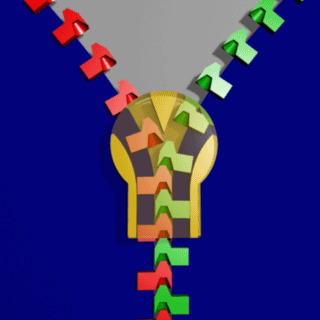One of the things that’s endlessly fascinating to me about math and
science is the way that, no matter how much we know, we’re constantly
discovering more things that we don’t know. Even in simple, fundamental
areas, there’s always a surprise waiting just around the corner.
A great example of this is something called the Ulam spiral,
named after Stanislaw Ulam, who first noticed it. Take a sheet of graph paper.
Put “1” in some square. Then, spiral out from there, putting one number in
each square. Then circle each of the prime numbers. Like the following:

If you do that for a while – and zoom out, so that you can’t see the numbers,
but just dots for each circled number, what you’ll get will look something like
this:

That’s the Ulam spiral filling a 200×200 grid. Look at how many diagonal
line segments you get! And look how many diagonal line segments occur along
the same lines! Why do the prime numbers tend to occur in clusters
along the diagonals of this spiral? I don’t have a clue. Nor, to my knowledge,
does anyone else!
And it gets even a bit more surprising: you don’t need to start
the spiral with one. You can start it with one hundred, or seventeen thousand. If
you draw the spiral, you’ll find primes along diagonals.
Intuitions about it are almost certainly wrong. For example, when I first
thought about it, I tried to find a numerical pattern around the diagonals.
There are lots of patterns. For example, one of the simplest ones is
that an awful lot of primes occur along the set of lines
f(n) = 4n2+n+c, for a variety of values of b and c. But what does
that tell you? Alas, not much. Why do so many primes occur along
those families of lines?
You can make the effect even more prominent by making the spiral
a bit more regular. Instead of graph paper, draw an archimedean spiral – that
is, the classic circular spiral path. Each revolution around the circle, evenly
distribute the numbers up to the next perfect square. So the first spiral will have 2, 3, 4;
the next will have 5, 6, 7, 8, 9. And so on. What you’ll wind up with is
called the Sack’s spiral, which looks like this:

This has been cited by some religious folks as being a proof of the
existence of God. Personally, I think that that’s silly; my personal
belief is that even a deity can’t change the way the numbers work: the
nature of the numbers and how they behave in inescapable. Even a deity who
could create the universe couldn’t make 4 a prime number.
Even just working with simple integers, and as simple a concept of
the prime numbers, there are still surprises waiting for us.




